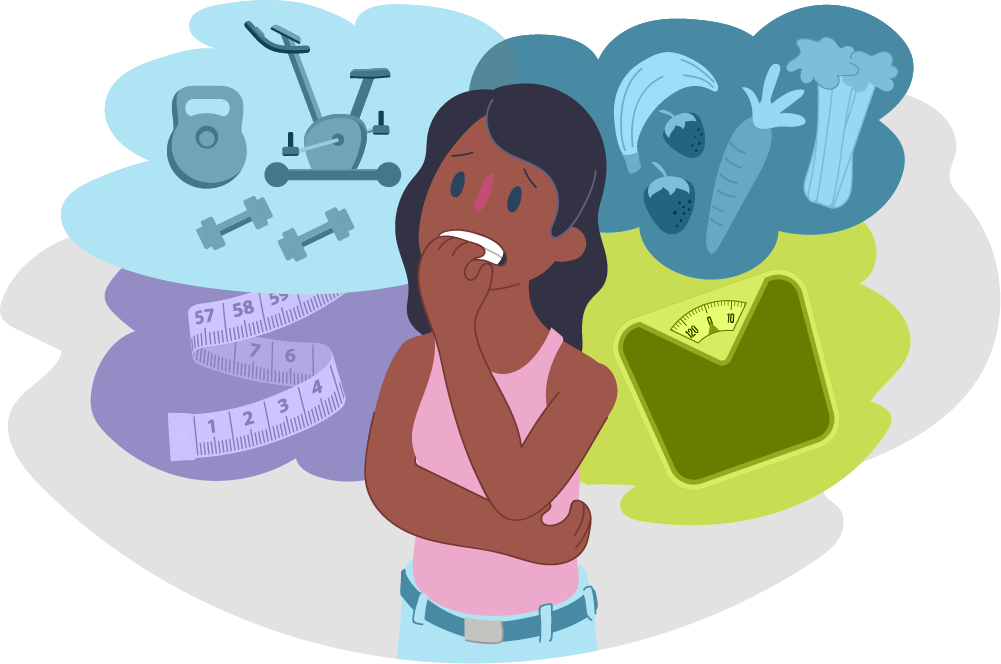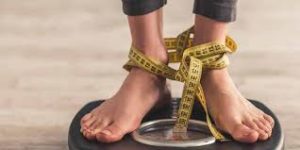Signs of Eating Disorders

Information on this page:
- Common Eating Disorders
- How to talk to someone you think might have an eating disorder
- Resources on and off campus
%
One in four men in college suffer from an eating disorder.
%
Over one in three women in college suffer from an eating disorder.
Common Eating Disorders:
Click the tabs on the right to read more about the signs and symptoms of the top eating disorders. To see a side-by-side comparison of the three, scroll down to the chart below.
Between 1.1% and 4.6% of females and 0.1% to 0.5% of males will develop bulimia.
Symptoms:
- Being preoccupied with your body shape and weight
- Repeated episodes of eating huge quantities of food in one sitting
- Feeling a loss of control — like you can’t stop eating or can’t control what you eat
- Forcing yourself to vomit or exercising too much to keep from gaining weigh
- Using laxatives, diuretics or enemas after eating when they’re not needed
- Fasting, restricting calories or avoiding certain foods between binges
- Using dietary supplements or herbal products excessively for weight loss

Between 0.2% and 3.5% of females and 0.9% and 2.0% of males will develop binge eating disorder.
Symptoms:
- Eating much more rapidly than normal.
- Eating until feeling uncomfortably full.
- Eating large amounts of food when not feeling physically hungry.
- Eating alone because of feeling embarrassed by how much one is eating.
- Feeling disgusted with oneself, depressed, or very guilty afterward.


If You or a Friend Needs Help, Try These Resources
Do's and Don't's of discussing eating disorders with sufferers:
- Having a conversation is the first step towards getting help!
- Worried about a friend or family member? Watch the first video.
- Worried about offending someone that may have an eating disorder? Watch the second video to learn some phrases to avoid.

Contact these on-campus resources if you are concerned about yourself or someone else:
Academic Support & Access Center: 202-885-3360
Counseling Center: 202-885-3500
Student Health Center: 202-885-3380
Health Promotion and Advocacy Center: 202-885-3275
Office of the Dean’s Care Network
If you think that someone needs help but do not feel comfortable reaching out to the resources above, the Dean’s Care Network is an annonymous way to find help.
Read about Olivia’s experience after her friends filed a care report in her name to the right. Thanks to this program, Olivia was able to get the care she needed to heal and move towards recovery. If a friend in your life needs help, they could benefit from the Care Network too. This service does not require a student to seek resourcces, it just provides them with on-campus individuals who are aware of their potential problems.
To learn more about this service or to send a care report, click the link below.
References:
1. Anorexia nervosa. (n.d.). NEDA. Retreived Sept. 23, 2019 from https://www.nationaleatingdisorders.org/learn/by-eating-disorder/anorexia.
2. Anorexia nervosa. (n.d.). Mayo Clinic. Retrieved Sept. 23, 2019 from https://www.mayoclinic.org/diseases-conditions/anorexia-nervosa/symptoms-causes/syc-20353591.
3. Eisenberg, D. et al. (2013). Eating disorder symptoms among college students: Prevlence, persistence, correlates, and treatment-seeking. J Am Coll Health, 59(8), 700-707. doi: 10.1080/07448481.2010.546461.
4. Images sourced from The Noun Project. Retireved Sept. 23, 2019 from thenounproject.com.
5. Bulimia nervosa. (n.d.). NEDA. Retreived Sept. 23, 2019 from https://www.nationaleatingdisorders.org/learn/by-eating-disorder/bulimia.
6. How to help a loved one (n.d.). NEDA. Retreived Sept. 23, 2019 from https://www.nationaleatingdisorders.org/learn/help/caregivers.
7. AU Care Network. (n.d.). American University . Retrieved Sept. 23, 2019 from https://www.american.edu/ocl/dos/care-network.cfm.

